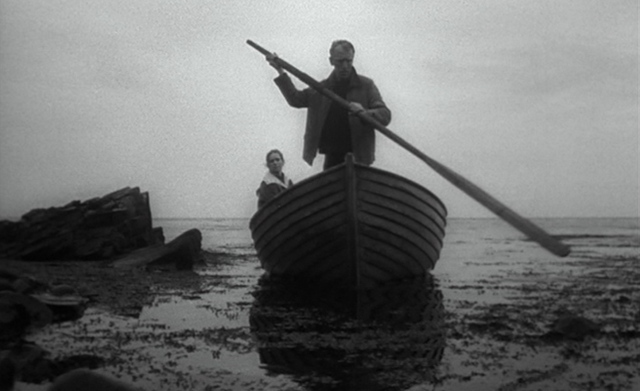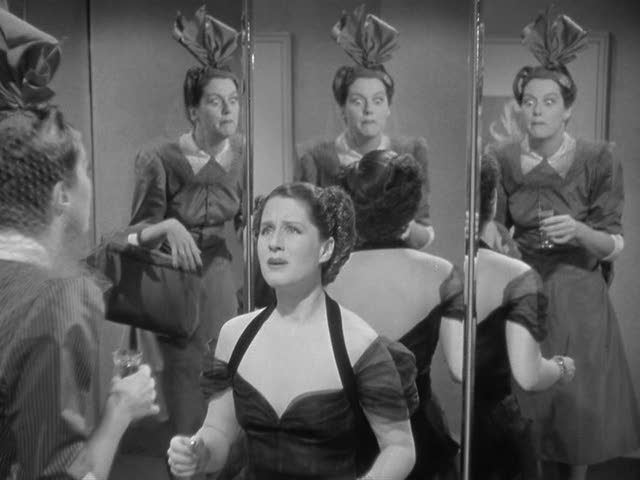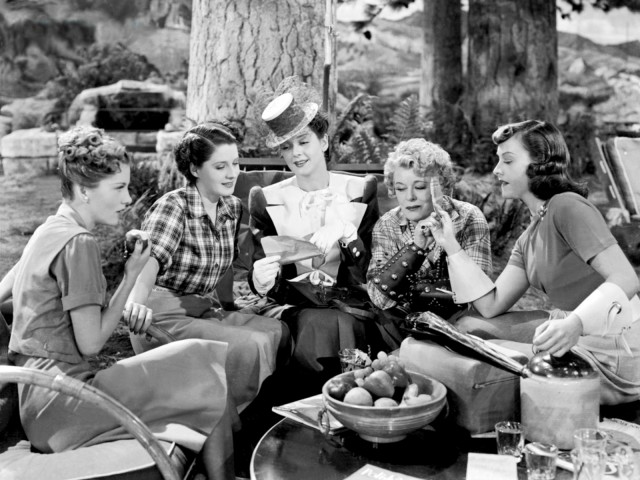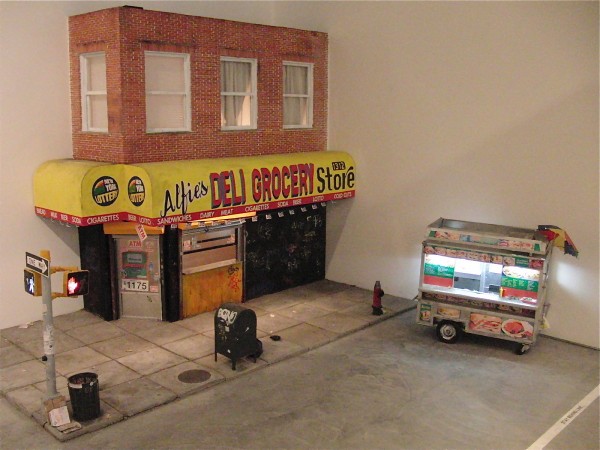
Drew Hamilton’s miniature “Street-Corner Project” is part of inaugural “Housewarming” show at BRIC House in Brooklyn (photo by twi-ny/mdr)
BRIC Arts | Media House
647 Fulton St.
Through December 15, free, 10:00 am – 8:00 pm
718-683-5600
www.bricartsmedia.org
There’s an artistic revolution going on in downtown Brooklyn on the other side of the LIRR station from where the Barclays Center now resides. BAM has added the Fisher to the Howard Gilman Opera House and Harvey Theater, right near the Mark Morris Dance Center, and down the street is Theatre for a New Audience’s dazzling new Polonsky Shakespeare Center, which is currently presenting its first production, Julie Taymor’s A Midsummer Night’s Dream. Another new entry in this growing community is the gorgeously revamped BRIC House, a multidisciplinary arts center that opened in its old digs at the corner of Rockwell and Fulton Sts. in October. Sunday is the last day to see its inaugural art exhibition, the appropriately titled “Housewarming: Notions of Home from the Center of the Universe.” Curated by BRIC director of contemporary art Elizabeth Ferrer, the display features works by twelve Brooklyn-based artists, including eight pieces specifically commissioned for this show, in the downstairs three-thousand-square-foot gallery. Keisha Scarville’s photographs from her “I am here” series offer dark, quiet contemplation of objects that recall home. Garry Nichols’s café mural and weather vanes evoke his Tasmanian birthplace. Abraham McNally’s small-scale wall sculptures contain fragments of a physically broken home. Margaret Reid Boyer’s “Household Objects” photos consists of domestic interiors in which something is often not quite right. Vargas-Suarez Universal’s “Star Chamber” can be seen on the building’s facade. Drew Hamilton re-creates the scene he used to see from his second-floor window at Graham Ave. and Merserole St. in Bushwick in the miniature replica “Street-Corner Project.” There are also works by Njideka Akunyili, Sonya Blesofsky, Esperanza Mayobre, Katarina Jerinic and Chad Stayrook, and Nathan Wasserbauer. It all makes for a tender welcome home to BRIC, which in the next few weeks is also hosting free dance classes with Ronald K. Brown / Evidence and Samita Sinha’s work-in-progress, Cipher, with David Levine, Christian Hawkey, and Joe Diebes’s “Wow” scheduled for January.

 Based on the true story of Somali pirates hijacking a Maersk container ship in the spring of 2009, Paul Greengrass’s Captain Phillips is a nonstop action thriller, a gripping film that is solidly one of the best of the year. Tom Hanks gives a riveting performance as Captain Richard Phillips, a merchant marine guiding the MV Maersk Alabama on its mission to deliver relief supplies to Somalia, Uganda, and Kenya, in addition to more standard cargo. A family man, he kisses his wife, Andrea (Catherine Keener), goodbye, then heads out on his journey, paying close attention to a memo warning of possible pirate activity. When small motorboats do indeed start approaching, Phillips tries diversionary tactics — the ship and crew were not permitted to carry any weaponry whatsoever back then — but he knows that it’s only a matter of time before they come back, and indeed the Alabama is soon boarded by four armed pirates led by Abduwali Muse (Barkhad Abdi), who capture Phillips and take over the ship. But things don’t go quite as planned for Phillips or the pirates, leading to a marvelously staged showdown finale. Greengrass, who has made such previous expert thrillers as Bloody Sunday, The Bourne Supremacy, and United 93, once again builds unrelenting tension every step of the way, even for those in the audience who might already know the outcome. The film centers on the complex relationship between the relatively easygoing Phillips and the desperate Muse, their eyes constantly meeting in penetrating gazes as they play an intense psychological game of cat and mouse. Hanks is a marvel as Phillips, giving brilliant nuance and texture to what could have been a one-note role but instead ends up being one of the finest of his outstanding career. All along the way, Greengrass keeps upping the ante, whether in a chase on the high seas or a claustrophobic battle of wills inside a lifeboat. There has been some controversy over the factual accuracy of the film, which is based on Phillips’s bestselling A Captain’s Duty: Somali Pirates, Navy SEALs, and Dangerous Days at Sea (written with Stephan Talty), but that doesn’t take anything away from what is a breathtaking cinematic experience.
Based on the true story of Somali pirates hijacking a Maersk container ship in the spring of 2009, Paul Greengrass’s Captain Phillips is a nonstop action thriller, a gripping film that is solidly one of the best of the year. Tom Hanks gives a riveting performance as Captain Richard Phillips, a merchant marine guiding the MV Maersk Alabama on its mission to deliver relief supplies to Somalia, Uganda, and Kenya, in addition to more standard cargo. A family man, he kisses his wife, Andrea (Catherine Keener), goodbye, then heads out on his journey, paying close attention to a memo warning of possible pirate activity. When small motorboats do indeed start approaching, Phillips tries diversionary tactics — the ship and crew were not permitted to carry any weaponry whatsoever back then — but he knows that it’s only a matter of time before they come back, and indeed the Alabama is soon boarded by four armed pirates led by Abduwali Muse (Barkhad Abdi), who capture Phillips and take over the ship. But things don’t go quite as planned for Phillips or the pirates, leading to a marvelously staged showdown finale. Greengrass, who has made such previous expert thrillers as Bloody Sunday, The Bourne Supremacy, and United 93, once again builds unrelenting tension every step of the way, even for those in the audience who might already know the outcome. The film centers on the complex relationship between the relatively easygoing Phillips and the desperate Muse, their eyes constantly meeting in penetrating gazes as they play an intense psychological game of cat and mouse. Hanks is a marvel as Phillips, giving brilliant nuance and texture to what could have been a one-note role but instead ends up being one of the finest of his outstanding career. All along the way, Greengrass keeps upping the ante, whether in a chase on the high seas or a claustrophobic battle of wills inside a lifeboat. There has been some controversy over the factual accuracy of the film, which is based on Phillips’s bestselling A Captain’s Duty: Somali Pirates, Navy SEALs, and Dangerous Days at Sea (written with Stephan Talty), but that doesn’t take anything away from what is a breathtaking cinematic experience.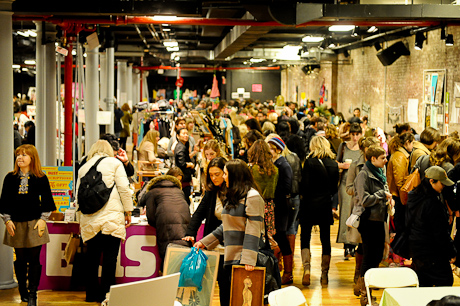
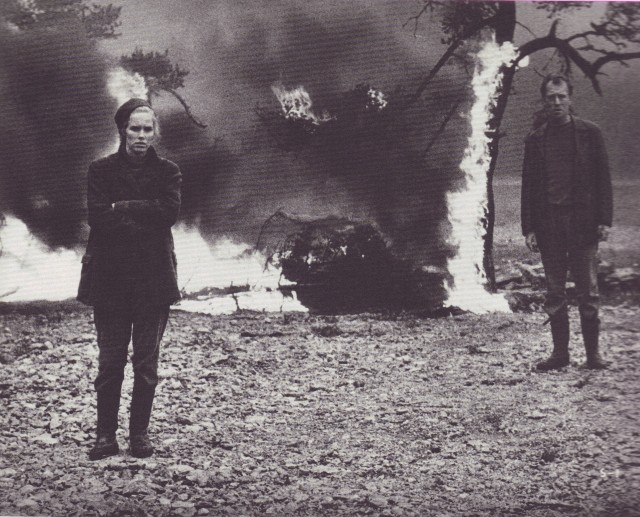
 Ingmar Bergman’s Shame is a brilliant examination of the physical and psychological impact of war, as seen through the eyes of a happily married couple who innocently get caught in the middle of the brutality. Jan (Max von Sydow) and Eva Rosenberg (Liv Ullmann) have isolated themselves from society, living without a television and with a broken radio, maintaining a modest farm on a relatively desolate island a ferry ride from the mainland. As the film opens, they are shown to be a somewhat ordinary husband and wife, brushing their teeth, making coffee, and discussing having a child. But soon they are thrust into a horrific battle between two unnamed sides, fighting for reasons that are never given. As Jan and Eva struggle to survive, they are forced to make decisions that threaten to destroy everything they have built together. Shot in stark black-and-white by master cinematographer Sven Nykvist, Shame is a powerful, emotional antiwar statement that makes its point through intense visual scenes rather than narrative rhetoric. Jan and Eva huddle in corners or nearly get lost in crowds, then are seen traversing a smoky, postapocalyptic landscape riddled with dead bodies. Made during the Vietnam War, Shame is Bergman’s most violent, action-filled film; bullets can be heard over the opening credits, announcing from the very beginning that this is going to be something different from a director best known for searing personal dramas. However, at its core, Shame is just that, a gripping, intense tale of a man and a woman who try to preserve their love in impossible times. Ullmann and von Sydow both give superb, complex performances, creating believable characters who will break your heart. Shame is screening December 14 and 18 at the Elinor Bunin Munroe Film Center as part of the Film Society of Lincoln Center series “Liv & Ingmar: The Films,” being held in conjunction with the theatrical release of Dheeraj Akolkar’s poetic new documentary, Liv & Ingmar; the festival continues with such other Ullmann/Bergman pairings as Scenes from a Marriage, Saraband, The Passion of Anna, and Persona.
Ingmar Bergman’s Shame is a brilliant examination of the physical and psychological impact of war, as seen through the eyes of a happily married couple who innocently get caught in the middle of the brutality. Jan (Max von Sydow) and Eva Rosenberg (Liv Ullmann) have isolated themselves from society, living without a television and with a broken radio, maintaining a modest farm on a relatively desolate island a ferry ride from the mainland. As the film opens, they are shown to be a somewhat ordinary husband and wife, brushing their teeth, making coffee, and discussing having a child. But soon they are thrust into a horrific battle between two unnamed sides, fighting for reasons that are never given. As Jan and Eva struggle to survive, they are forced to make decisions that threaten to destroy everything they have built together. Shot in stark black-and-white by master cinematographer Sven Nykvist, Shame is a powerful, emotional antiwar statement that makes its point through intense visual scenes rather than narrative rhetoric. Jan and Eva huddle in corners or nearly get lost in crowds, then are seen traversing a smoky, postapocalyptic landscape riddled with dead bodies. Made during the Vietnam War, Shame is Bergman’s most violent, action-filled film; bullets can be heard over the opening credits, announcing from the very beginning that this is going to be something different from a director best known for searing personal dramas. However, at its core, Shame is just that, a gripping, intense tale of a man and a woman who try to preserve their love in impossible times. Ullmann and von Sydow both give superb, complex performances, creating believable characters who will break your heart. Shame is screening December 14 and 18 at the Elinor Bunin Munroe Film Center as part of the Film Society of Lincoln Center series “Liv & Ingmar: The Films,” being held in conjunction with the theatrical release of Dheeraj Akolkar’s poetic new documentary, Liv & Ingmar; the festival continues with such other Ullmann/Bergman pairings as Scenes from a Marriage, Saraband, The Passion of Anna, and Persona.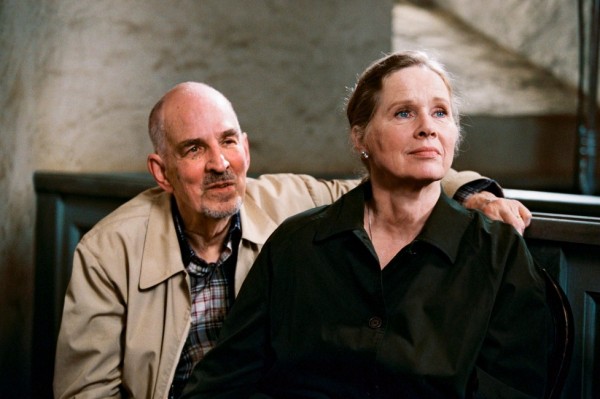
 Two-time Oscar-nominated Norwegian actress Liv Ullmann intimately and poetically discusses her five-decade-long personal and professional relationship with Swedish director Ingmar Bergman in Dheerai Alkolkar’s beautifully rendered Liv & Ingmar. Ullmann returns to Bergman’s house on Faro Island as she openly and honestly shares details of their long involvement, which began in 1965 when they were filming Persona; Ullmann was twenty-five, Bergman forty-six. Each was married and ended up leaving their spouse for what became a tumultuous five-year affair, after which they remained friends and colleagues, ultimately making twelve films together between 1966 and 2004. Alkolkar and cinematographer Hallvard Bræin zoom in on Ullmann’s expressive face as her memories go from love, loneliness, rage, and pain to longing and friendship. Alkolkar intersperses related film clips, behind-the-scenes footage, home movies, and snapshots as Ullmann walks along the beach and reads from her 1977 memoir, Changing; the film also features Samuel Fröler in voice-over reading from Bergman’s letters and autobiography, The Magic Lantern. Among the works featured prominently are Shame and Scenes from a Marriage, which eerily evoke Ullmann and Bergman’s real-life relationship. Liv & Ullmann serves as a lovely coda to this lasting partnership, which continues in its own unique way even after Bergman’s death in 2007 at the age of eighty-nine. In conjunction with the theatrical release of the film at Lincoln Center, the Film Society will also be screening nine works starring Ullmann and directed by Bergman: Shame, The Passion of Anna, Cries and Whispers, Face to Face, Scenes from a Marriage, Saraband, Hour of the Wolf, Persona, and Autumn Sonata.
Two-time Oscar-nominated Norwegian actress Liv Ullmann intimately and poetically discusses her five-decade-long personal and professional relationship with Swedish director Ingmar Bergman in Dheerai Alkolkar’s beautifully rendered Liv & Ingmar. Ullmann returns to Bergman’s house on Faro Island as she openly and honestly shares details of their long involvement, which began in 1965 when they were filming Persona; Ullmann was twenty-five, Bergman forty-six. Each was married and ended up leaving their spouse for what became a tumultuous five-year affair, after which they remained friends and colleagues, ultimately making twelve films together between 1966 and 2004. Alkolkar and cinematographer Hallvard Bræin zoom in on Ullmann’s expressive face as her memories go from love, loneliness, rage, and pain to longing and friendship. Alkolkar intersperses related film clips, behind-the-scenes footage, home movies, and snapshots as Ullmann walks along the beach and reads from her 1977 memoir, Changing; the film also features Samuel Fröler in voice-over reading from Bergman’s letters and autobiography, The Magic Lantern. Among the works featured prominently are Shame and Scenes from a Marriage, which eerily evoke Ullmann and Bergman’s real-life relationship. Liv & Ullmann serves as a lovely coda to this lasting partnership, which continues in its own unique way even after Bergman’s death in 2007 at the age of eighty-nine. In conjunction with the theatrical release of the film at Lincoln Center, the Film Society will also be screening nine works starring Ullmann and directed by Bergman: Shame, The Passion of Anna, Cries and Whispers, Face to Face, Scenes from a Marriage, Saraband, Hour of the Wolf, Persona, and Autumn Sonata.